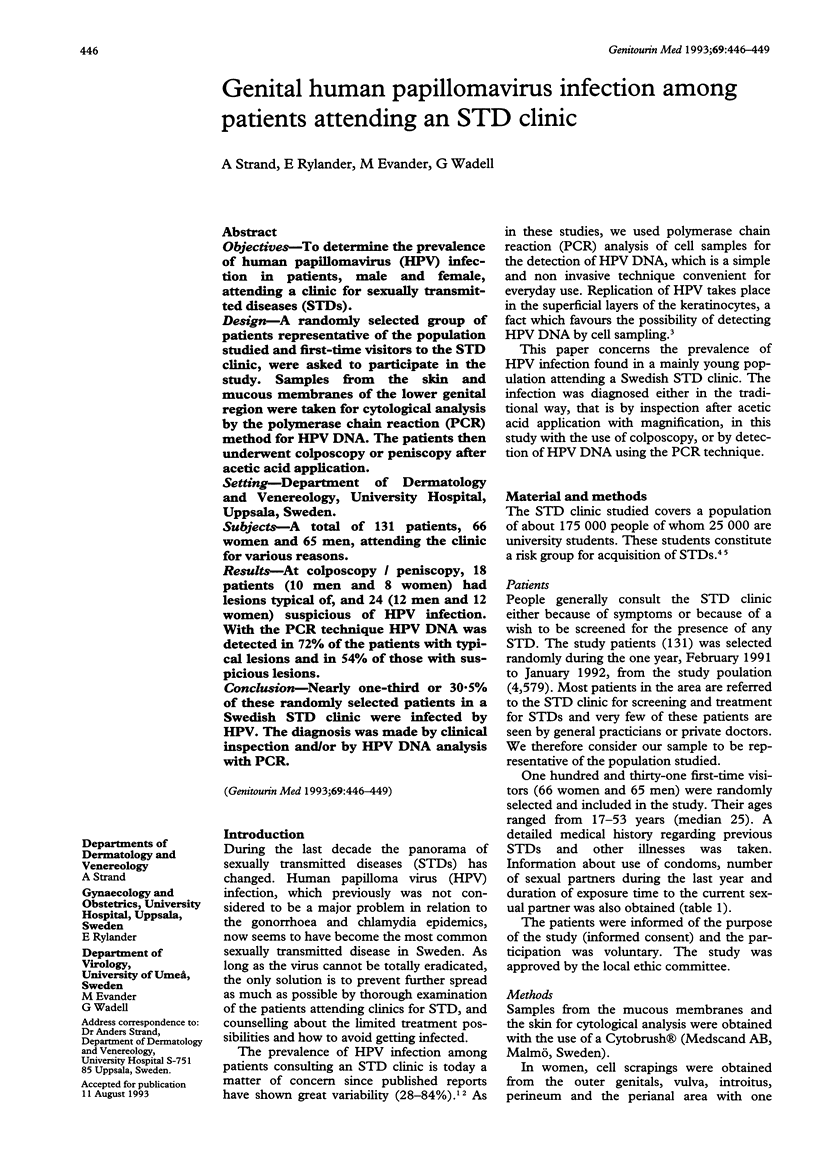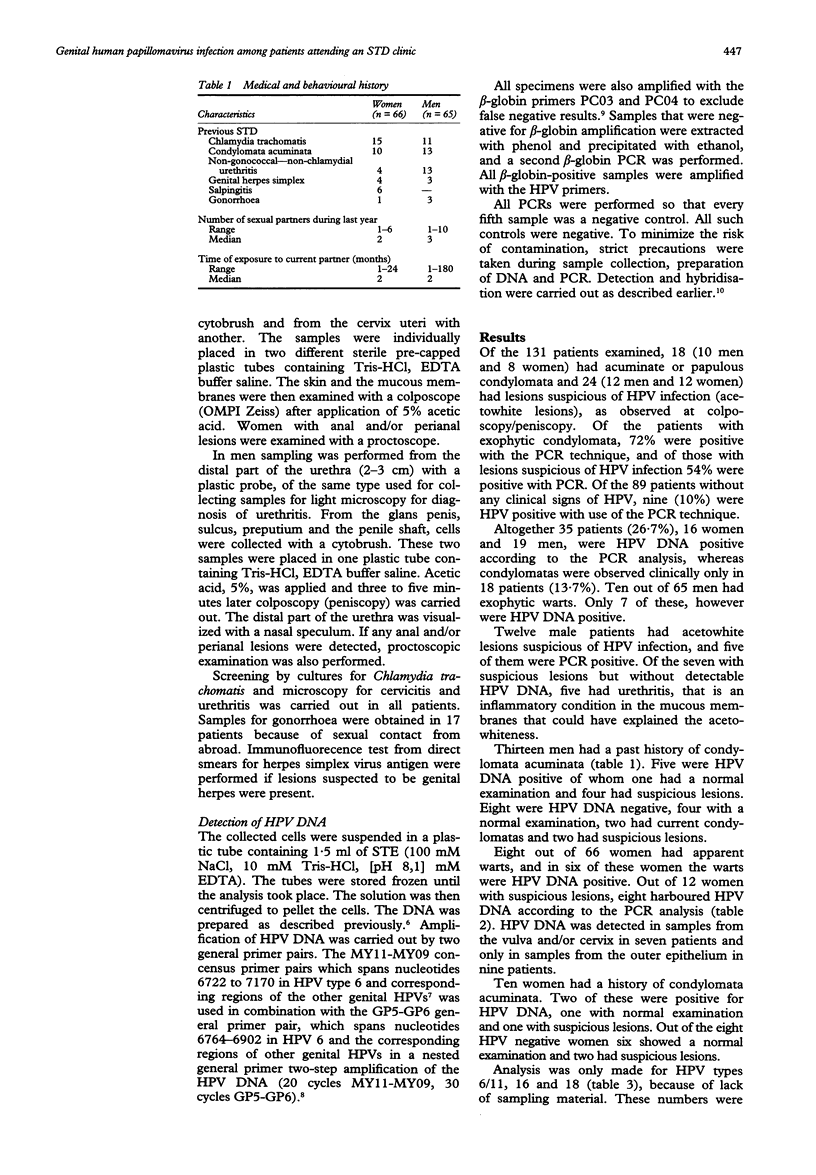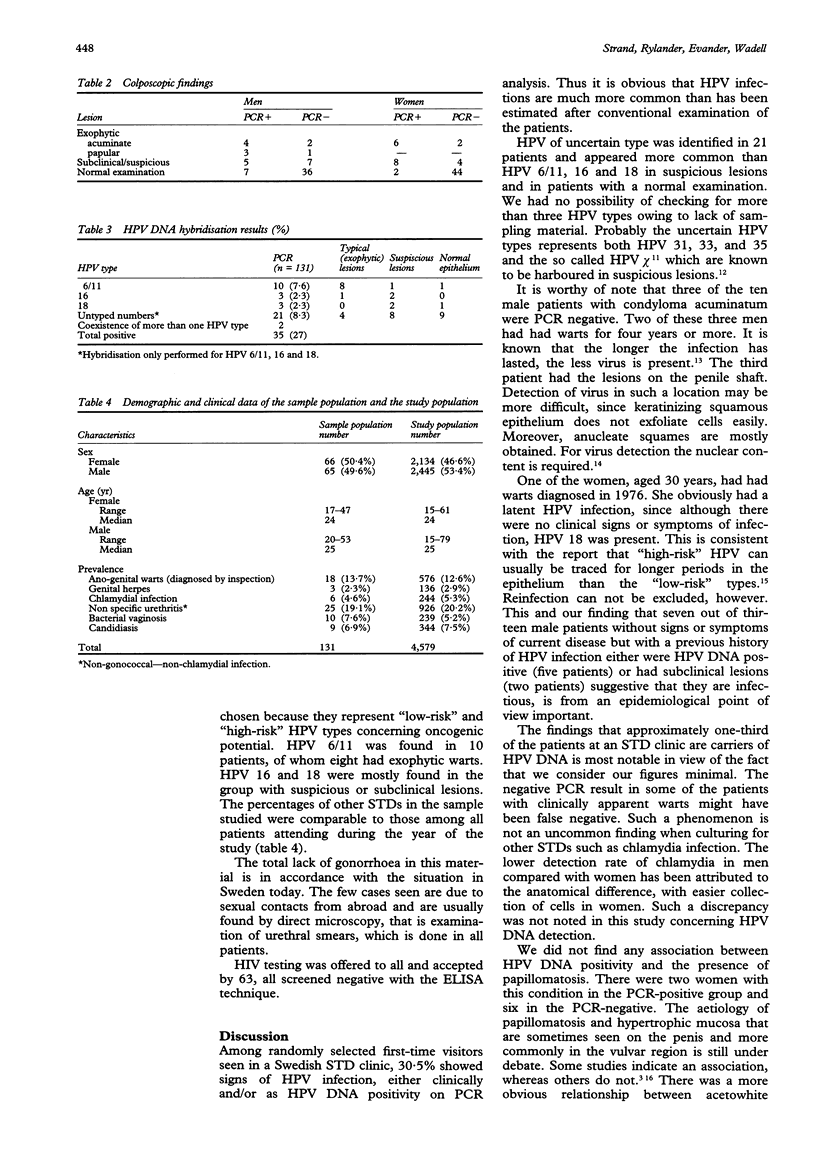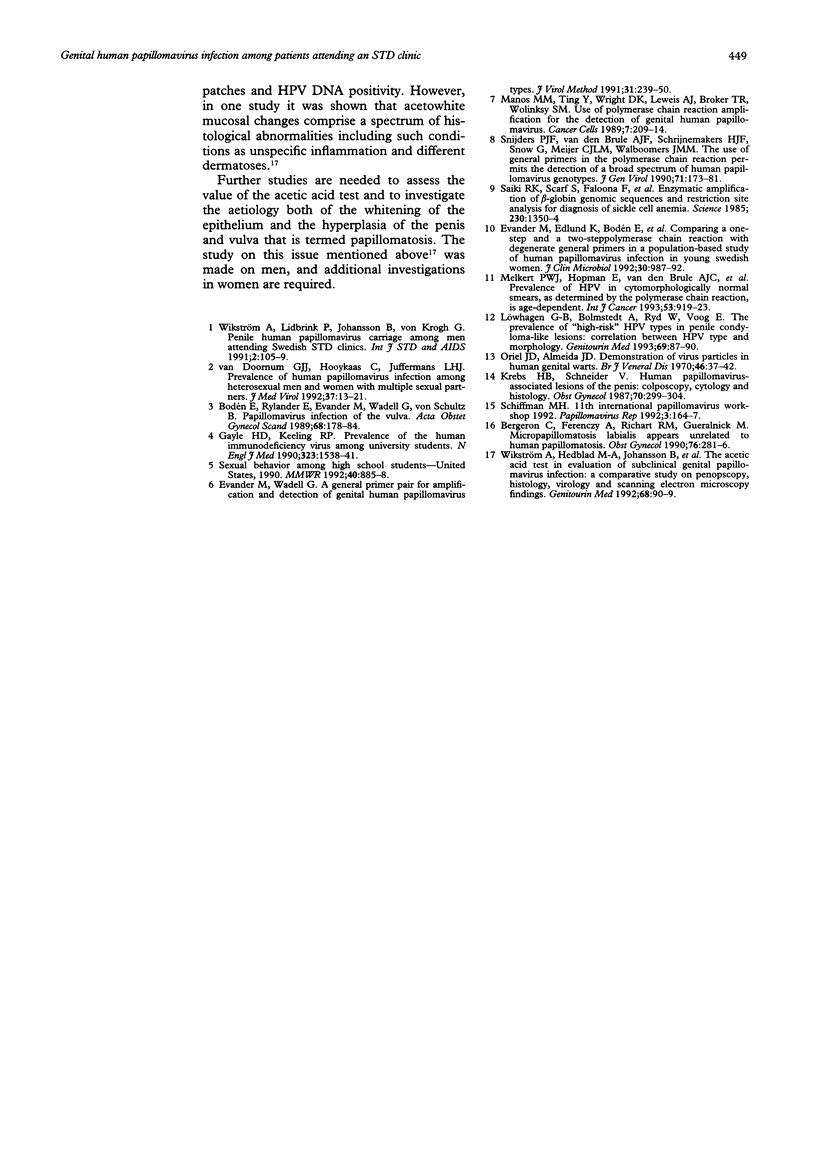Abstract
OBJECTIVES--To determine the prevalence of human papillomavirus (HPV) infection in patients, male and female, attending a clinic for sexually transmitted diseases (STDs). DESIGN--A randomly selected group of patients representative of the population studied and first-time visitors to the STD clinic, were asked to participate in the study. Samples from the skin and mucous membranes of the lower genital region were taken for cytological analysis by the polymerase chain reaction (PCR) method for HPV DNA. The patients then underwent colposcopy or peniscopy after acetic acid application. SETTING--Department of Dermatology and Venereology, University Hospital, Uppsala, Sweden. SUBJECTS--A total of 131 patients, 66 women and 65 men, attending the clinic for various reasons. RESULTS--At colposcopy/peniscopy, 18 patients (10 men and 8 women) had lesions typical of, and 24 (12 men and 12 women) suspicious of HPV infection. With the PCR technique HPV DNA was detected in 72% of the patients with typical lesions and in 54% of those with suspicious lesions. CONCLUSION--Nearly one-third or 30.5% of these randomly selected patients in a Swedish STD clinic were infected by HPV. The diagnosis was made by clinical inspection and/or by HPV DNA analysis with PCR.
Full text
PDF



Selected References
These references are in PubMed. This may not be the complete list of references from this article.
- Bergeron C., Ferenczy A., Richart R. M., Guralnick M. Micropapillomatosis labialis appears unrelated to human papillomavirus. Obstet Gynecol. 1990 Aug;76(2):281–286. [PubMed] [Google Scholar]
- Evander M., Edlund K., Bodén E., Gustafsson A., Jonsson M., Karlsson R., Rylander E., Wadell G. Comparison of a one-step and a two-step polymerase chain reaction with degenerate general primers in a population-based study of human papillomavirus infection in young Swedish women. J Clin Microbiol. 1992 Apr;30(4):987–992. doi: 10.1128/jcm.30.4.987-992.1992. [DOI] [PMC free article] [PubMed] [Google Scholar]
- Evander M., Wadell G. A general primer pair for amplification and detection of genital human papillomavirus types. J Virol Methods. 1991 Feb-Mar;31(2-3):239–250. doi: 10.1016/0166-0934(91)90162-s. [DOI] [PubMed] [Google Scholar]
- Gayle H. D., Keeling R. P., Garcia-Tunon M., Kilbourne B. W., Narkunas J. P., Ingram F. R., Rogers M. F., Curran J. W. Prevalence of the human immunodeficiency virus among university students. N Engl J Med. 1990 Nov 29;323(22):1538–1541. doi: 10.1056/NEJM199011293232206. [DOI] [PubMed] [Google Scholar]
- Krebs H. B., Schneider V. Human papillomavirus-associated lesions of the penis: colposcopy, cytology, and histology. Obstet Gynecol. 1987 Sep;70(3 Pt 1):299–304. [PubMed] [Google Scholar]
- Löwhagen G. B., Bolmstedt A., Ryd W., Voog E. The prevalence of "high-risk" HPV types in penile condyloma-like lesions: correlation between HPV type and morphology. Genitourin Med. 1993 Apr;69(2):87–90. doi: 10.1136/sti.69.2.87. [DOI] [PMC free article] [PubMed] [Google Scholar]
- Melkert P. W., Hopman E., van den Brule A. J., Risse E. K., van Diest P. J., Bleker O. P., Helmerhorst T., Schipper M. E., Meijer C. J., Walboomers J. M. Prevalence of HPV in cytomorphologically normal cervical smears, as determined by the polymerase chain reaction, is age-dependent. Int J Cancer. 1993 Apr 1;53(6):919–923. doi: 10.1002/ijc.2910530609. [DOI] [PubMed] [Google Scholar]
- Oriel J. D., Almeida J. D. Demonstration of virus particles in human genital warts. Br J Vener Dis. 1970 Feb;46(1):37–42. doi: 10.1136/sti.46.1.37. [DOI] [PMC free article] [PubMed] [Google Scholar]
- Saiki R. K., Scharf S., Faloona F., Mullis K. B., Horn G. T., Erlich H. A., Arnheim N. Enzymatic amplification of beta-globin genomic sequences and restriction site analysis for diagnosis of sickle cell anemia. Science. 1985 Dec 20;230(4732):1350–1354. doi: 10.1126/science.2999980. [DOI] [PubMed] [Google Scholar]
- Snijders P. J., van den Brule A. J., Schrijnemakers H. F., Snow G., Meijer C. J., Walboomers J. M. The use of general primers in the polymerase chain reaction permits the detection of a broad spectrum of human papillomavirus genotypes. J Gen Virol. 1990 Jan;71(Pt 1):173–181. doi: 10.1099/0022-1317-71-1-173. [DOI] [PubMed] [Google Scholar]
- Wikström A., Hedblad M. A., Johansson B., Kalantari M., Syrjänen S., Lindberg M., von Krogh G. The acetic acid test in evaluation of subclinical genital papillomavirus infection: a comparative study on penoscopy, histopathology, virology and scanning electron microscopy findings. Genitourin Med. 1992 Apr;68(2):90–99. doi: 10.1136/sti.68.2.90. [DOI] [PMC free article] [PubMed] [Google Scholar]
- Wikström A., Lidbrink P., Johansson B., von Krogh G. Penile human papillomavirus carriage among men attending Swedish STD clinics. Int J STD AIDS. 1991 Mar-Apr;2(2):105–109. doi: 10.1177/095646249100200205. [DOI] [PubMed] [Google Scholar]
- van Doornum G. J., Hooykaas C., Juffermans L. H., van der Lans S. M., van der Linden M. M., Coutinho R. A., Quint W. G. Prevalence of human papillomavirus infections among heterosexual men and women with multiple sexual partners. J Med Virol. 1992 May;37(1):13–21. doi: 10.1002/jmv.1890370104. [DOI] [PubMed] [Google Scholar]


